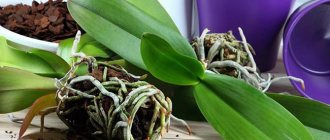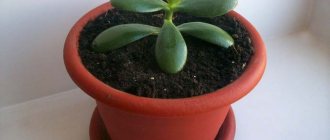Do you have an orchid growing, but you don’t know how to replant it at home? Read the article, it contains a lot of useful tips and instructions.
The orchid, just like the rose, can be called the queen of flowers. Graceful flowers, decorative leaves, intertwining roots and stems create a plant of incredible beauty. But this flower, like all the others, needs good care, an important component of which is replanting. It needs to be done correctly and on time - the further development of the plant and the abundance of flowering, as well as the duration of the adaptation process, depend on this.
Read another article on our website that tells how to propagate an orchid at home with children, cuttings, roots, and seeds. All methods are described in detail.
This article describes the timing, as well as the rules for transplanting a home orchid. You will learn how to replant a flower after the store and why to do it at all. Read on.
Why replant an orchid when grown at home: is it replanted at all, is it possible?
Orchid transplantation at home
Various circumstances may arise under which a transplant is performed. Why replant an orchid when growing it at home? Is it possible to replant at all? Yes, this can and should be done. Here are the circumstances under which flower breeding experts advise doing this:
- Replanting is required once every 3-4 years after purchasing or replanting the plant.
- If it is noticed that the roots have begun to appear from the pot, i.e. it has become too small for the plant.
- If the orchid is very sick, all its leaves begin to turn yellow.
- Unsightly appearance and condition of the substrate in which the flower grows. Mold or severe dryness of the upper fragments has appeared on the surface, which indicates a loss of the filler’s ability to pass water and air.
- The plant does not bloom for several years, and then it needs a good shake-up in the form of a transplant.
- If necessary, divide the orchid.
If these signs are not observed, it is better not to touch the orchid - it does not really like to be disturbed. It is also not recommended to do this during the flowering process; it is better to wait until it is over, unless an urgent transplant is needed.
Reasons for transplantation
Both professionals and amateurs strive to create optimal conditions for their home plant, which open up many opportunities for development for the flower. But we must not forget that transplantation is a dangerous and sometimes even harmful procedure associated with stress and other risks.
A transplant can only be performed in certain cases:
Newly purchased plant. After you have bought a new orchid, inspect the soil in which it grows. If the phalaenopsis substrate contains soil, then replanting is required, since if it grows for a long time in such soil outside of specialized greenhouse conditions, the flower will not live long. If the substrate consists only of bark and/or coco chips, then carefully remove the top layer and make sure that there is no “cup” of coco peat or sphagnum under the base of the orchid. If you find such a “glass”, then the flower should be replanted and the “glass” should be removed, since it is too moisture-intensive and can lead to rotting of the orchid’s base.
Replanting is associated with the soil losing its basic properties. As time passes after the last movement of the flower, the substrate becomes of poor quality, compacting at the level of the growth point and at the point of attachment of the roots, losing the ability to properly supply the root system with air. In addition, mineral fertilizers and simply salts dissolved in water for irrigation are deposited in the substrate. The reason for replanting is the process of rotting of soil components such as moss or fern. The bark gradually decomposes and becomes too moisture-intensive, rotten and unsuitable for the orchid. If the reason for replanting is the salinity of the substrate, then it is allowed to replace only the upper saline part of the soil, so as not to unnecessarily disturb the plant.
Important! If the soil mostly consists of bark, then replanting should be done no more than once every 2 years, while soil where moss predominates requires more frequent replacement - once every 2 years.
The root system of representatives of the orchid family grows no less actively than their above-ground part, so it is necessary to carefully monitor its condition. In the case when the container in which the home beauty grows becomes cramped, the orchid needs to be replanted. It is very easy to visually determine whether the pot is suitable in volume for the current stage of flower development. Through the transparent walls it is clearly visible when the orchid roots have nowhere else to grow and intertwine. If a dense tangle of roots has formed in the pot, then this is a sure sign that it is time to replant the plant. If there is not enough living space, part of the root system may die, which is also easy to notice .
The reason for changing the container and soil may be one of the diseases of the root system. Diseases are reflected in the appearance of the flower: leaves wither, flowers fall, color changes. Very often, atrophy and rotting of the roots occurs. In this case, it is necessary to remove all dead roots and treat the plant with a fungicide.
Improper care of your home beauty often becomes the reason for replanting an orchid. External indicators of improper care are yellowing of leaves, loss of elasticity, drying out of the root system.
Flower damage by pests. Not all parasites settle on the above-ground parts of the pet. Some of them affect the root system. In this case, the flower must be treated with pest control drugs and must be replanted.
Timing: when can an orchid be replanted?
Replanting an orchid at home
This operation should be carried out when the dormant period of the inflorescences and the entire plant has ended. But there are types of orchids in which the dormant period is weakly expressed, for example, phalaenopsis, which blooms almost all year round with short breaks. Therefore, if new shoots of a plant do not develop in the absence of signs of disease, it means that it is entering a dormant period. This is the best time to replant. This time usually occurs in the spring - late February and March. This is the best time to replant an orchid.
When can you seat?
The optimal time to transplant an orchid is spring, the period of active flower growth . You should not disturb him in the fall and winter - from October to February, unless absolutely necessary. A newly purchased plant must be replanted as soon as the first flowering ends or within a year after purchase.
The monopoly subspecies should be replanted only when green tips appear at the roots, and the sympodial subspecies should be replanted as soon as new shoots appear, but before their roots begin to grow.
Frequency of orchid transplantation at home: how often?
Replanting an orchid at home
Many novice flower lovers ask the question: “How often to replant an orchid?” . What determines the frequency of transplanting inflorescences at home?
- The answer to this question depends on what composition of the substrate is in the container.
- It may consist of moss, and then it needs to be replanted more often - once every two years .
- If the main part of the substrate is bark, which decomposes more slowly, then you can replant it once every three years.
Of course, these dates are indicated for planned replantings, when the inflorescence looks completely healthy and has no signs of damage by insects.
How to decorate it beautifully?
An orchid is an incredibly beautiful and self-sufficient element of the interior that can complement a beautifully decorated pot.
Both natural and artificial materials are suitable for decorating a pot , for example:
- moss;
- all kinds of wood elements;
- bright pot stands;
- DIY coasters made from natural materials;
- vessels made of ceramics and clay;
- brackets for hanging flowers.
Substrate for orchid transplantation at home: what is it made of?
Substrate for transplanting orchids at home
To transplant orchids at home, you need to choose a high-quality substrate. The health and further flowering process of the plant largely depends on this. What is it made of? You can buy a specialized one at retail outlets, but it comes in two types:
- For epiphytic (i.e. with aerial roots). It's called Phalaenopsis Mixture.
- For terrestrials - “Mixture for Cymbidium”.
The first mixture is used for flowers growing on trees with long aerial roots. Therefore, the substrate for them must be breathable, because the roots of these flowers take part in photosynthesis and they do not need soil, only moisture, to grow. The composition of such mixtures usually includes:
- Pine bark
- Ground fern root
- Activated carbon
- Cut cork
- Sphagnum in small quantities
The second type of mixture is denser, because it is intended for orchids living on the ground. It contains more of these ingredients:
- Sphagnum moss
- Lowland peat
- Leaf ground
- Coal
Sometimes various synthetic materials, such as perlite or foam, are used as a substrate. You can also use:
- Expanded clay
- Shell rock
- Pumice
The substrate can be made at home. Pine bark is used for this:
- First disinfect it - hold it over steam for half an hour or boil it in water.
- After this, dry and boil again. This treatment kills all pathogenic organisms.
- Place to dry again and then cut into pieces up to 2 cm .
To the bark prepared in this way, add dry and finely chopped sphagnum moss and just a little peat coal. You can now fill the pots with this mixture.
Cuttings are a last resort measure to save a dying orchid
Cuttings obtained from peduncles are rooted in a nutrient medium . The cut areas are treated with cinnamon and the peduncle is dried for exactly one day. The dormant bud is lubricated with cytokinin paste and the peduncle is lowered into a container (glass, jar or bottle), at the bottom of which rain or boiled water (2-3 cm) is poured.
Activated carbon is poured onto the bottom. Necessary :
- Bright place;
- Increased humidity levels;
- And temperatures.
Which pot is best to replant a home orchid?
It is better to replant the orchid in a transparent pot.
Most orchids have large roots that like to entwine the pot from the inside and even look out. Therefore, when choosing a new container for a flower, you need to focus primarily on the size of the root system. But, given that the base of the flower will grow further, you need to add a few centimeters to the diameter. Which pot is best to replant a home orchid?
Worth knowing: For a large orchid with intensive growth, you can buy a pot, as they say, “for growth,” so as not to replant it often.
Orchid lovers most often grow their “beauties” in plastic transparent pots or containers. What are the advantages of such containers? Here is the answer:
- The roots are clearly visible and you can constantly monitor their condition. With normal soil moisture, the roots are usually green, but as the substrate dries, they gradually turn gray, which indicates the need for watering.
- In plastic containers, unlike clay ones, the roots do not grow to the walls of the container and therefore are not injured during replanting.
Although clay containers have their advantages:
- In them, the base-root does not overheat, which is very important for orchids.
- Do not overwater the plant because the moisture will last longer.
- In addition, a clay pot is much heavier than a plastic one and therefore will not tip over. Orchids are planted in such pots, some of the roots of which completely dry out and die during the dormant period.
Be sure to make drainage holes in the containers. This will provide the roots with faster drying and ventilation, which will protect them from rotting. Flower lovers with no experience often overwater the plant for fear of drying it out. Drainage holes will help in this case too.
Worth knowing: Plastic containers have one drawback - they have a rather simple, not very sophisticated appearance, compared to the flower itself. To correct this shortcoming, you can buy a beautiful flowerpot that will completely hide the plastic.
There is another way out - you can put a plastic pot in a low glass vase. The space between the walls of the vase and the pot is filled with some kind of jewelry or tinsel, balls or floral fillers. This needs to be done carefully so that the multi-colored filler does not distract from the beauty of the orchid flowers.
Remember: Do not buy large containers for orchids. In small ones - up to 15 cm in diameter, it feels much better and blooms longer.
Right choice
Capacities
What should you place the orchid in? Is it possible in a regular ceramic pot?
The ideal pot for an orchid is a transparent container with many holes . Such a pot will provide free access of air and light to the roots and will allow you to monitor their condition. If ceramic pots are chosen for planting orchids, they must be glazed and have a sufficient number of side holes. In addition, it will allow you to control the moisture level in the substrate.
Tip : When choosing a pot, you also need to rely on the size and volume of the root system: it should be about 2 times larger than the roots.
We recommend watching a video about choosing a pot for replanting an orchid:
Earth
Depending on the type of orchid, there are 2 types of substrate:
for epiphytic orchids, consisting of fern roots, oak or birch charcoal, peat moss and pine bark;- for terrestrial orchids containing coal, peat, sphagnum moss, leaf humus and bark.
Ideal soil for any type of orchid includes charcoal, bark, peat, moss, fern roots, foam and chistos.
We recommend watching a video about the types of soils for orchids:
How to transplant children, one child, a shoot of a home orchid: step-by-step instructions
Replanting a baby home orchid
An orchid growing in normal, ideal conditions can produce young shoots, or babies. This is a great opportunity to propagate the plant. What should be done? How to transplant children, one child, a shoot of a home orchid? Here are the instructions step by step:
- The baby should have fairly long roots - more than 5 cm and 3-4 leaves - these are the most suitable parameters for transplantation.
- Children usually appear on the stem or near the root collar. Using a sharp knife, you need to cut off part of the stem with the baby, stepping back to the sides at a distance of about 1 cm . Sprinkle the cut area with coal.
- Prepare a small glass in advance, preferably a plastic one, and add a small layer of drainage.
- Place the baby in a glass and carefully cover it with substrate. for the first 3-4 days .
- Place the glass with the baby in a place where the air humidity is high. You can simply spray the surface of the window sill where the glass is located more often. Try not to get it on the leaves.
The baby will grow in such a container for about a year, after which it can be transplanted into a larger container. An orchid grown from a child will bloom in three years .
Features of working with plants
With indoor and outdoor
When keeping an orchid at home or outdoors, its nutrition can only be replenished by completely replacing the soil, so replanting must be done regularly. During replanting and replacing the substrate, you need to change the composition familiar to the flower, but in order for adaptation to be easy, a little of the old soil is placed in the new pot.
During or after flowering
In order to separate the old soil from the plant when replanting during flowering or after it, you need to place the roots in a container with water at room temperature . Rotten roots must be cut off and the cut areas treated with an antiseptic. Next, you need to pour drainage and bark into the bottom of the new pot, place the orchid in it, pour the soil mixture to the middle, compact it and sprinkle it with bark.
Further proper care of the phalaenopsis orchid plant after transplantation, growing conditions
After replanting, you need to provide proper and timely further care for the orchid. Here are the conditions for growing a phalaenopsis orchid plant:
Proper care of an orchid is to shade the window so that the sun does not burn the leaves of the flower.
- As mentioned above, immediately after the transplantation is made, the container is placed on a sunny windowsill for a week, but shaded from direct sunlight. Otherwise, if this is not done, the orchid leaves will lose their decorative appearance, wrinkle and become wilted.
You can water the flower after transplanting only after a couple of weeks.
- water the plant after replanting only after 2 weeks . The fact is that orchid roots are susceptible to various fungal diseases. Therefore, the root system needs to be slightly dried to avoid this. Find out how to properly water an orchid here .
Spraying the plant so as not to dry it out
- But, in order not to dry out the plant, spray the leaves, or, even better, wipe them with a wet sponge. In this case, under no circumstances should water get into the depths of the rosette of leaves. This can lead to their rotting.
Orchid grows at optimal temperature
- It is important to maintain optimal temperature. The orchid does not like heat, it needs a temperature no higher than +21-22°C , but it should not fall below 18°C . Otherwise, the inflorescences get stressed, which is very undesirable for these sissies.
Feed the orchid
- A blooming orchid needs feeding. Use only mineral mixtures. Organic ones are not suitable for feeding flowers, since they can introduce diseases into the soil.
Excessive nitrogen nutrition can cause leaf growth to the detriment of flowering. Nowadays you can find special fertilizer compounds for orchids in stores. In any case, it will be good to use an all-purpose fertilizer for flowering plants. They must be diluted strictly according to the instructions so as not to harm the flower. They need to be added along with water for irrigation.
Process technology
Capacity
It should be noted right away that orchids are absolutely indifferent to the material and shape of the pot. You can use any utensils , from ordinary plastic to expensive ceramic pots.
However, you need to remember that most types of orchids are epiphytes and they use their roots for respiration and photosynthesis , so it is preferable to use transparent plastic containers.
Advice! Some "ground" orchids can be planted in regular pots.
The size of the container should be 1-2 sizes larger than the previous one , this is enough to fit almost all the roots. If an orchid is being resuscitated and some of the roots have rotted, then, accordingly, a smaller pot of appropriate size is needed.
The pot must have drainage holes , and for epiphytes it is important that the pot also has holes on the walls. If it is plastic, then making them is quite simple. The size of the holes should be about 1 cm in diameter, larger is possible, but make sure that the substrate does not fall out through them.
For the most part, orchids prefer cramped pots rather than spacious ones.
Some gardeners mount their orchids on blocks or shards . This design looks very impressive, but requires special care and daily spraying.
Substrate
It should be said right away that most orchids are epiphytes; in nature they grow on supports (trees, branches, etc.). This means that indoor orchids only need a substrate to:
- To gain a foothold and stay in space;
- And also to maintain the level of humidity near the roots.
Most often, pine bark is used as a substrate for orchids.
The exception, perhaps, is the same “earth” species.
The main criterion by which a substrate is selected is its density . So, a store-bought substrate with all sorts of additives in the form of moss or peat is perfect for earthen orchids. This substrate is denser and heavier and in most cases is not suitable for epiphytic species, such as Phalaenopsis.
In this case, the purchased substrate , selecting pieces of bark of the largest fraction, into which the plant is planted.
The best solution is to harvest pine bark yourself . It is collected from a pine tree that has fallen in the forest. Make sure that there is as little resin on the bark as possible. Then the bark:
- Disinfect;
- Divide into cubes or pieces of 2-3 cm;
- And they dry it.
Large pieces of bark will allow air to flow more freely and ventilate the pot .
Advice! Add a handful of old substrate to the fresh substrate to “populate” beneficial microflora.
Preliminary abundant watering
Most orchids have thick, succulent and fragile roots
They can be easily damaged during transplantation. Therefore, before removing the plant from the old pot, it needs to be watered generously so that the roots become more flexible. Place the pot in a basin or other container and fill with water for 10 minutes.
This procedure does not guarantee 100% flexibility ; be careful and gentle with the plant.
Removing from the pot and cleaning the roots from old soil
After the orchid has absorbed water, the pot must be slightly kneaded with your fingers to stir the substrate and the plant is removed from the pot . This must be done carefully for the reasons described above.
It often happens that the roots of an old orchid have become intertwined and grown into the holes in the pot . In this case, the pot will have to be cut with scissors or a knife - another plus of plastic dishes. Ceramic pots are carefully broken with hammer blows.
When the plant is removed from the pot, it is inspected. The old substrate is crushed . If pieces of bark stick to the roots, do not try to peel them off. Dip the plant in water for another 10-15 minutes, the bark will get wet and fall off on its own.
Removing old rotten roots, processing cuts
After the roots are completely cleaned, cut off the rotten areas . They are easy to distinguish - they are hollow and brown in color.
Rotten orchid roots must be removed.
For pruning, use a sharp tool whose blades should be disinfected. Sprinkle the slices with crushed coal or cinnamon. Then the orchid is left to dry for six hours.
Moving to new ground
The pot is filled 1/3 full with substrate and the plant is placed in it. Be careful with the roots - carefully straighten them and place them in the pot. The voids are filled with substrate. Do not push roots that do not fit into the pot - they can be easily broken; it is better to remain outside the pot. The substrate is compacted with water from the shower.
Important! If the orchid is large, place several pebbles on the bottom of the pot as weight - they will not allow the plant to tip over and fall.
If there is no flowering after transplantation: what to do?
Lack of flowering after transplantation
After transplantation, the orchid should increase its green mass and bloom after a certain time. This usually happens after 3-4 months . But what if the inflorescences do not appear for much longer? What to do if there is no flowering after transplantation? This problem can occur for several reasons:
- The plant is overfed with nitrogen fertilizers , active leaf growth is observed, they become larger than they should be during normal development. In this case, feeding should be stopped for a month.
- The transplant was not carried out in a timely manner . For example, if for some reason an orchid was transplanted at the time when it bloomed last year, then it most likely will not bloom this year. The plant will direct all its energy to restoring its root system, and not to flowering.
- Perhaps you made mistakes during transplantation . If the plant is not firmly fixed in the substrate, then when you move the pot, it begins to dangle in it, and the roots and stems will receive microtrauma. The plant does not have the opportunity to direct its energy to flowering, experiencing constant stress.
- Insufficient lighting and low humidity . You need to move the pot to a lighter windowsill and spray its surface to increase the humidity of the surrounding air.
Follow these tips, and your flower will soon delight you with its unique blooms. It's worse when the plant begins to wilt. What to do? Read on.
Basic Rules
Before you begin such a responsible process, prepare thoroughly. If the transplantation procedure takes place after active flowering, you need to carefully trim the peduncle. Thanks to this, the orchid will be able to put all its energy into restoration.
First of all, prepare your tools. You will need:
- well-sharpened scissors or small pruning shears;
- large transparent plastic pot;
- activated carbon or bactericidal preparations that do not contain alcohol;
- new substrate.
Please note: be sure to treat all instruments involved in the process with an alcohol-containing solution. The orchid must be completely protected from microbes.
During transplantation, be sure to disinfect the pot and all tools
A regular planned transplant or even an emergency one is not the only difficulty that lovers of exotic flowers face. To plant an orchid, making several from one flower, you also need to follow certain rules.
How to properly plant an orchid from shoot to flowering tree
Professionals distinguish 3 methods of planting exotic plants, including orchids.
- Propagating a flower from a new stem is the most common method. After the plant drops its flower stalks, small new cuttings will appear in the pot. These are the very “babies” that can be transplanted into another pot and soon you will get a new full-fledged orchid.
- You can plant an orchid using roots. Use this method if the root system and bulb have grown quite strongly. Carefully cut off an equal part of them and plant them in a separate pot. Remember that this method is unacceptable for the phalaenopsis orchid.
- The next method is to cut off the side shoot immediately after flowering. Place this shoot in moist, warm soil for several weeks and then plant it in a permanent pot.
Now you know the features of planting an orchid, and we will move on to a step-by-step description of the process.
What to do if your home orchid withers after transplantation?
A home orchid withers after transplantation.
Most likely the plant is sick. If planting rules are violated, when mechanical damage to the roots occurs, the leaves do not receive full nutrition. What to do if your home orchid withers after transplantation? Here are the tips:
If you watered a lot, replant the plant:
- With good watering and stagnation of liquid at the bottom of the container, especially if there is no drainage, the roots may begin to rot.
- Then the wilting will soon be replaced by yellowing of the leaves and the plant may die.
- Here an emergency orchid transplant will be needed to save it.
Control pests:
- Another reason could be a pest attack.
- Spider mites, the worst pests of indoor plants, thrive in dry air.
- It can be difficult to notice them right away - they are very small and the bad effects begin to appear when there are a lot of them.
- Whiteflies and scale insects also harm orchids. Providing optimal air humidity will help to significantly reduce the number of these insects.
Protect from the sun:
- If the orchid is not protected from direct sunlight, its leaves will begin to wilt.
- This indoor flower feels best on windows that face east, where the sun appears only in the morning and for a short time.
Containers must be provided with drainage holes, and they need to be made not only at the very bottom of the container, but also on the sides to ensure good air exchange for the roots.
How to properly water a home orchid flower?
Well-groomed orchid flowers
Watering a home orchid flower is carried out by immersion in water, the temperature of which is not lower than +20°C , so as not to cause stress to the plant. How to do this correctly? Here is the answer:
- To do this, take a cup with warm liquid and place the container with the plant in it for 20 minutes .
- Then take it out and place it on a wire rack to drain off excess water.
- Then place the flower in its usual place.
In winter, the number of waterings should be reduced, but in summer, on the contrary, this should be done more often, at least twice a week. It is necessary to monitor the pseudobulb - if it has lost turgor, then watering is necessary.
Important: It is forbidden to take long breaks between waterings. The orchid is a tropical plant that naturally lives in times of frequent rain and high humidity. Therefore, drought is detrimental to it.
Care
There are several rules for caring for an orchid after transplantation:
- it is necessary to limit access to sunlight by placing the plant in the shade;
- the temperature in the room with the orchid should not exceed 20-22 degrees;
- the most suitable place for an orchid would be an east window;
- the first watering is carried out after 3-5 days;
- you need to spray the flower with warm water;
- You can feed the plant with fertilizers after a month.
How to replant an orchid flower if the root is rotten: tips
Replanting an orchid flower if the root has rotted
Infrequently, but there are cases when novice gardeners, as a result of improper care, have the roots of an orchid rot. This can happen to all the roots or to a large part of them at once. Is it possible to save the plant then? How to replant an orchid flower if the root is rotten? Here are the tips:
- To revive orchids whose roots have completely died, you need a small window greenhouse.
- In the container where the leaf rosette will be located, you need to pour a small layer of drainage - this can be expanded clay or pebbles.
- Place sphagnum moss on top, which is previously kept over steam and dried.
- Now moisten the substrate and place the leaf rosette in it.
- Transfer to a greenhouse, where a constant temperature should be maintained within +21 - +27°C and high humidity of about 100% . The light should be bright, but diffused - direct sunlight is detrimental to leaves during this period.
After 3-4 weeks of this regime, root rudiments will begin to appear at the base of the leaf rosette and then they will begin to grow. Epin , to the water for irrigation .
If a diseased orchid has several living roots left, or even just one, the chances of saving it increase:
- After trimming the rotten roots, you need to rinse the remaining living roots under warm water and sprinkle the cut areas with charcoal.
- A pre-prepared pot up to 8 cm in diameter is filled with ordinary substrate and a leaf rosette with roots is planted in it.
- Next, the plant is treated as in the first case, placing it in a greenhouse.
If everything went well, new roots will begin to grow in 2-4 weeks .
What needs to be prepared?
Before you start replanting a flower, you need to prepare the following equipment:
new pot;- medical gloves;
- small pruning shears;
- sharp scissors or knife;
- new substrate;
- drainage;
- alcohol for processing pruners or scissors;
- activated carbon, brilliant green or other antiseptic for treating orchid sections;
- peduncle holders.
Is it possible to replant a flowering orchid while it is blooming?
You can replant orchids during flowering, but in the most urgent cases.
There is only one situation in which you can replant a blooming orchid - if it is in danger of dying for any reason and you need to choose one of two:
- The orchid will fade, but then die, having spent its last energy on flowering.
- The peduncle is cut short, but later with good care, the plant is completely restored and after a while it will bloom again.
What to do in the second case? Adviсe:
- Prepare fresh substrate and pot. How to do this has already been said above in the text.
- Cut the flower stalks of the orchid to about 2/3 of the length. By the way, the flowers can be placed in water - they will last for almost a week.
- Carefully remove the plant from the pot and inspect the roots, cutting out any rotten ones.
- If the substrate is in normal condition, i.e. there is no mold or its smell, it is not overdried or, on the contrary, very waterlogged, then in this case you need to try to preserve it as much as possible without shaking off the roots. Otherwise, proceed as with a regular transplant, the procedure of which has already been described.
- Now you need to place the plant in the pot and secure it well there.
All that remains is to put the orchid, transplanted during flowering, into the greenhouse and observe how it will feel further. Do not forget to follow all the rules for caring for this flower, which are no more complicated than the rules for caring for other indoor flowers.
How to separate the baby?
Before cutting the baby from the mother flower, you need to let it grow and wait until the roots become 3-5 cm in length. Now the baby can be cut off, leaving at least 1 cm of the peduncle. You need to treat the cut areas and leave the shoot in water for 15 minutes. The baby should be planted in a disinfected substrate in the same way as an adult plant.
Attention : Only one orchid shoot can be planted in one pot.
We recommend watching a video about separating a baby orchid:











